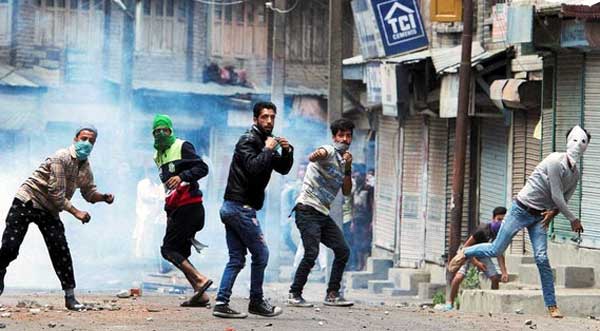 Kashmir, adorned with sparkling streams, lush meadows, snow-carpeted mountains and dense forests, has long been a muse to many poets. Among the most beautiful places on earth, the valley has been trapped in a vicious cycle of violence, built over decades of resentment and neglect, resurrecting an old problem that has been festering intermittently for 70 years.
Kashmir, adorned with sparkling streams, lush meadows, snow-carpeted mountains and dense forests, has long been a muse to many poets. Among the most beautiful places on earth, the valley has been trapped in a vicious cycle of violence, built over decades of resentment and neglect, resurrecting an old problem that has been festering intermittently for 70 years.
Young boys, mostly in their teens, are out on streets. Armed with rocks in their hands, their faces masked, they come close to police and paramilitary men, shout for “freedom from India,” glorify Islam with slogans in Arabic and throw stones at the security forces.
The men in uniform retaliate with tear gas and shotguns that fire small-bore pellets. Live bullets are also fired, and another Kashmiri home is bereaved.
For the second year in a row, Kashmir appears headed for another summer of unrest, after around 100 civilians died in firing by security forces after the July 8, 2016 killing of local militant Burhan Wani.
Wani, 22, had a rock star-like following and had emerged as a symbol of new age anti-India armed rebellion.
Why are Kashmiris protesting?
Jammu and Kashmir – the only Muslim-majority state in India – has been disputed between India and Pakistan since the partition of the Indian sub-continent in 1947. Both claim the entire territory, but rule only parts. They have fought two wars (1948 and 1965) and engaged in a limited military conflict in Kargil (1999) over the strategically crucial region.
In 1989, an armed insurgency erupted with Pakistan’s covert support, leaving over 70,000 people – civilians, militants and security personnel – dead in 28 years of an apparently unending conflict. With fatigue setting in, the region breathed in peace through the 2000s, before unrest flared in 2008 and 2010.
The peace sustained mainly because the Indian government engaged with Kashmiri separatists and with Pakistan to resolve the dispute. The talks, initiated by the BJP government led by Prime Minister Atal Bihari Vajpayee, broke down in 2008 after the deadly Mumbai attack by Pakistani terrorists.
Violence engulfed the valley last year when “normalcy” came to mean no newspapers, no internet, no schools, no business and no offices for six months.
On April 9, 2017,when Srinagar Lok Sabha constituency held a by-poll where only 7% of the electorate voted, protesters tried to storm polling stations to stop those who had come out to vote defying a separatist-called poll boycott. Security forces opened fire at the protesters at various place and eight civilians were killed.
Since then, streets in the Kashmir Valley, particularly its southern part, have turned to be daily battlegrounds for young boys, some even in their early teens, who engage security forces in a battle of stones versus teargas, pellets and bullets.
The biggest obstacle to any lasting solution to recurrent violence in Kashmir is India’s insistence on seeing anything that happens there through the prism of Pakistan. The government’s immediate reaction to any violent incident has always been to accuse Islamabad, its army and the Inter-Services Intelligence (ISI) of meddling in Kashmir.
There is no end in sight to the violence, particularly after the government of India in unambiguous terms ruled out the possibility of talks with Pakistan or separatists to ease tension in the valley.
Persisting with the government’s strong-armed approach, Prime Minister Modi’s senior colleagues, Home Minister Rajnath Singh and Defence Minister Arun Jaitley have clearly stated that the government would not talk politics with separatists and there would be no relaxation for militants – local or foreign – and stone-pelting protestors.
The situation further worsened when an army officer – Major Leetul Gogoi – was honoured for tying a Kashmiri man to the bonnet of a jeep and using him as a human shield to allow an army convoy to pass through a stone-pelting mob.
Indian Army Chief General Bipin Rawat made provocative statements like “people must be afraid…people have got to be afraid of us”.
Such statements and the government’s apparent indifference attitude have a potentially devastating effect on the psyche of the Kashmiri youth, already exposed to the dangerous online outpouring of Islamist radicalisation.
The problems in Kashmir – called “the paradise on Earth” – will continue and anger won’t fizzle out soon unless the Indian government acknowledges that Kashmiris, irrespective of their political and sovereign aspirations, are generally ambivalent about being identified with India.
There needs to be a lasting political solution to the issue if the state is to remain at peace with India.
Home Minister Rajnath Singh said June 3 that his government was working towards a “permanent solution” to the Kashmir issue but it would take time. A permanent solution would be found “by taking Kashmiri people into confidence,” he said, but “would not happen overnight.”
Targeting separatist leaders, Singh said they were instigating Kashmiri youth at the behest of Pakistan, a “country that cannot handle its own problems”.
“There is no doubt, no confusion that Pakistani is fomenting terror in Kashmir. But we will ensure that terrorism is uprooted from Kashmir soon. The violence will not last long,” Singh stated.
Courtesy: http://southasiamonitor.org/news/kashmir-anger-will-not-go-away-soon/sl/23796




